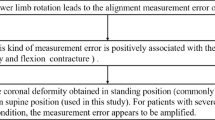Abstract
Purpose
Rotation of the lower limbs in long-leg radiographs has a significant impact on imaging the mechanical femorotibial angle, the femoral anatomic mechanical angle, the mechanical lateral distal femoral angle (mLDFA) and the mechanical medial proximal tibial angle (mMPTA). In this study, we assessed the rotation of the lower limbs in conventional radiographs and hypothesized that the relative position of the proximal fibula to the proximal tibia on long-leg radiographs is related to the rotation of the knee joint.
Methods
Radiological examinations in different rotational positions of the knee joint (incremental 40° internal to 40° external rotation) were imitated by 50 computed tomography scans (50 patients, 25 men and 25 women). The extent of the projection overlaps of the fibula, the fibular tip and the distance from the fibular tip to the lateral cortex were determined for every rotational position.
Results
Multiple regression analysis showed a very strong correlation between the measured fibular parameters and knee rotation between 20° of internal rotation and 40° of external rotation (R 2 ~ 0.94, p < 0.001). By means of these results, we created a formula for predicting knee rotation:
This strong correlation could not be found between 20° and 40° of internal rotation.
Discussion
Because incorrect internal and external rotation negatively influence the correct measurement of angles (mechanical femorotibial angle, femoral anatomic mechanical angle, the mLDFA and the mMPTA), long-leg radiographs should be assessed for proper rotation angles before measurement. Using the provided formula rotation of the lower limb in weight-bearing, long-leg radiographs can be reliably predicted.
Level of evidence
Diagnostic study, Level II.




Similar content being viewed by others
References
Akagi M, Oh M, Nonaka T, Tsujimoto H, Asano T, Hamanishi C (2004) An anteroposterior axis of the tibia for total knee arthroplasty. Clin Orthop Relat Res 420:213–219
Bäthis H, Perlick L, Tingart M, Lüring C, Perlick C, Grifka J (2004) Radiological results of image-based and non-image-based computer-assisted total knee arthroplasty. Int Orthop 28(2):87–90
Burghardt RD, Hinterwimmer S, Bürklein D, Baumgart R (2013) Lower limb alignment in the frontal plane: analysis from long standing radiographs and computer tomography scout views: an experimental study. Arch Orthop Trauma Surg 133(1):29–36
Deakin AH, Sarungi M (2014) A comparison of variable angle versus fixed angle distal femoral resection in primary total knee arthroplasty. J Arthroplasty 29(6):1133–1137
Deakin AH, Basanagoudar PL, Nunag P, Johnston AT, Sarungi M (2012) Natural distribution of the femoral mechanical-anatomical angle in an osteoarthritic population and its relevance to total knee arthroplasty. Knee 19(2):120–123
Dexel J, Kirschner S, Günther KP, Lützner J (2013) Agreement between radiological and computer navigation measurement of lower limb alignment. Knee Surg Sports Traumatol Arthrosc. doi:10.1007/s00167-013-2599-4
Gromov K, Korchi M, Thomsen MG, Husted H, Troelsen A (2014) What is the optimal alignment of the tibial and femoral components in knee arthroplasty? Acta Orthop. doi:10.3109/17453674.2014.940573
Issa SN, Dunlop D, Chang A, Song J, Prasad PV, Guermazi A, Peterfy C, Cahue S, Marshall M, Kapoor D, Hayes K, Sharma L (2007) Full-limb and knee radiography assessments of varus-valgus alignment and their relationship to osteoarthritis disease features by magnetic resonance imaging. Arthritis Rheum 57(3):398–406
Jawhar A, Wasnik S, Scharf HP, Roehl H (2014) Fibula head is a useful landmark to predict the location of posterior cruciate ligament footprint prior to total knee arthroplasty. Int Orthop 38:267–272
Kannan A, Hawdon G, McMahon SJ (2012) Effect of flexion and rotation on measures of coronal alignment after TKA. J Knee Surg 25(5):407–410
Kellgren JH, Lawrence JS (1957) Radiological assessment of osteo-arthrosis. Ann Rheum Dis 16:494–502
Lee YS, Lee BK, Lee SH, Park HG, Jun DS, Moon DH (2013) Effect of foot rotation on the mechanical axis and correlation between knee and whole leg radiographs. Knee Surg Sports Traumatol Arthrosc 21(11):2542–2547
Lonner JH, Laird MT, Stuchin SA (1996) Effect of rotation and knee flexion on radiographic alignment in total knee arthroplasties. Clin Orthop Relat Res 331:102–106
Luyckx T, Vanhoorebeeck F, Bellemans J (2014) Should we aim at undercorrection when doing a total knee arthroplasty? Knee Surg Sports Traumatol Arthrosc. doi:10.1007/s00167-014-3185-0
Novotny J, Gonzalez MH, Amirouche FM, Li YC (2001) Geometric analysis of potential error in using femoral intramedullary guides in total knee arthroplasty. J Arthroplasty 16(5):641–647
Paley D, Herzenberg JE, Tetsworth KT, McKie J, Bhave A (1994) Deformity planning for frontal an sagittal plane corrective osteotomies. Orthop Clin North Am 25:425–466
Radtke S, Becher C, Noll Y, Ostermeier S (2010) Effect of limb rotation on radiographic alignment in total knee arthroplasties. Arch Orthop Trauma Surg 130:451–457
Tsukeoka T, Tsuneizumi Y, Lee TH (2013) The effect of the posterior slope of the tibial plateau osteotomy with a rotational error on tibial component malalignment in total knee replacement. Bone Joint J 95:1201–1203
Victor J (2009) Rotational alignment of the distal femur: a literature review. Orthop Traumatol Surg Res 95(5):365–372
Acknowledgments
We would like to thank Ms. Monika Schoell for the linguistic revision of the manuscript.
Author information
Authors and Affiliations
Corresponding author
Rights and permissions
About this article
Cite this article
Maderbacher, G., Schaumburger, J., Baier, C. et al. Predicting knee rotation by the projection overlap of the proximal fibula and tibia in long-leg radiographs. Knee Surg Sports Traumatol Arthrosc 22, 2982–2988 (2014). https://doi.org/10.1007/s00167-014-3327-4
Received:
Accepted:
Published:
Issue Date:
DOI: https://doi.org/10.1007/s00167-014-3327-4




